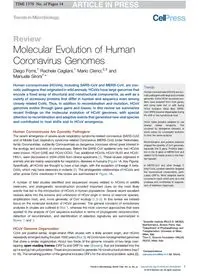
2016 Molecular Evolution of Human Coronavirus Genomes PDF
Preview 2016 Molecular Evolution of Human Coronavirus Genomes
Review Molecular Evolution of Human Coronavirus Genomes Diego Forni,1 Rachele Cagliani,1 Mario Clerici,2,3 and Manuela Sironi1,* Human coronaviruses (HCoVs), including SARS-CoV and MERS-CoV, are zoo- notic pathogens that originated in wild animals. HCoVs have large genomes that encode a fixed array of structural and nonstructural components, as well as a variety of accessory proteins that differ in number and sequence even among closely related CoVs. Thus, in addition to recombination and mutation, HCoV genomes evolve through gene gains and losses. In this review we summarize recent findings on the molecular evolution of HCoV genomes, with special attention to recombination and adaptive events that generated new viral species and contributed to host shifts and to HCoV emergence. Human Coronaviruses Are Zoonotic Pathogens The recent emergence of severe acute respiratory syndrome-related coronavirus (SARS-CoV) and of Middle East respiratory syndrome-related Coronavirus (MERS-CoV) (order Nidovirales, family Coronaviridae, subfamily Coronavirinae) as dangerous zoonoses stirred great interest in the ecology and evolution of coronaviruses. Before the SARS-CoV epidemic only two HCoVs were known: HCoV-229E and HCoV-OC43. Two additional HCoVs, HCoV-NL63 and HCoV- HKU1, were discovered in 2004–2005 from clinical specimens [1]. These viruses originated in animals and are mainly responsible for respiratory diseases in humans (Figure 1A, Key Figure). Specifically, all HCoVs are thought to have a bat origin, with the exception of lineage A beta- CoVs, which may have reservoirs in rodents [2]. The phylogenetic relationships of HCoVs and other animal CoVs mentioned in this review are summarized in Figure 1A. A number of field studies identified and sequenced viruses related to HCoVs in wildlife reservoirs, and phylogenetic reconstruction provided important clues on the most likely events that [8_TD$DIF]led to the introduction of HCoVs in human populations. Several recent excellent reviews delve into the knowns and unknowns of HCoV origin in terms of reservoir species, amplification host, and, more generally, of CoV ecology [1,3–5]. In this review we instead focus on the molecular evolution of HCoV genomes. The general concepts of evolutionary analyses in viruses are outlined in Box 1, whereas the most common approaches that were applied to the analysis of CoV sequence evolution in terms of phylogenetic reconstruction, detection of recombination, and identification of selection signatures are summarized in Boxes 1 and 2. HCoV Genome Organization CoVs are positive-sense, single-strand RNA viruses with a likely ancient origin, and HCoVs repeatedly emerged during the past 1000 years (Box 3). All CoVs have nonsegmented genomes that share a similar organization. About two thirds of the genome consists of two large over- lapping open reading frames (ORF1a and ORF1b; see Glossary), that are translated into the pp1a and pp1ab polyproteins. These are processed to generate 16 nonstructural proteins (nsp1 to 16). The remaining portion of the genome includes ORFs for the structural proteins: spike (S), Trends Human coronaviruses (HCoVs) are zoo- notic pathogens with large and complex genomes.[7_TD$DIF] Some HCoV accessory pro- teins were acquired from host genes, and some were lost or split during HCoV evolution. Most likely SARS- CoV ORF8 became dispensable during the shift to the human/civet host. HCoV spike proteins adapted to use diverse cellular receptors. This occurred by divergence followed, in some cases, by convergent evolution to bind the same receptor. Recombination and positive selection shaped the diversity of CoV genomes, especially the S gene. Positive selec- tion in the S gene of MERS-CoV and related CoVs mainly acted on the hep- tad repeats. In MERS-CoV and other lineage C beta-CoVs, positive selection targeted the nonstructural components, parti- cularly ORF1a. Most adaptive events occurred in nsp3, which acts as a viral protease and contributes to suppres- sion of interferon responses. 1Scientific Institute IRCCS E. MEDEA, Bioinformatics, Bosisio Parini, Italy 2Department of Physiopathology and Transplantation, University of Milan, Milan, Italy 3Don C. Gnocchi Foundation ONLUS, IRCCS, Milan, Italy *Correspondence:
